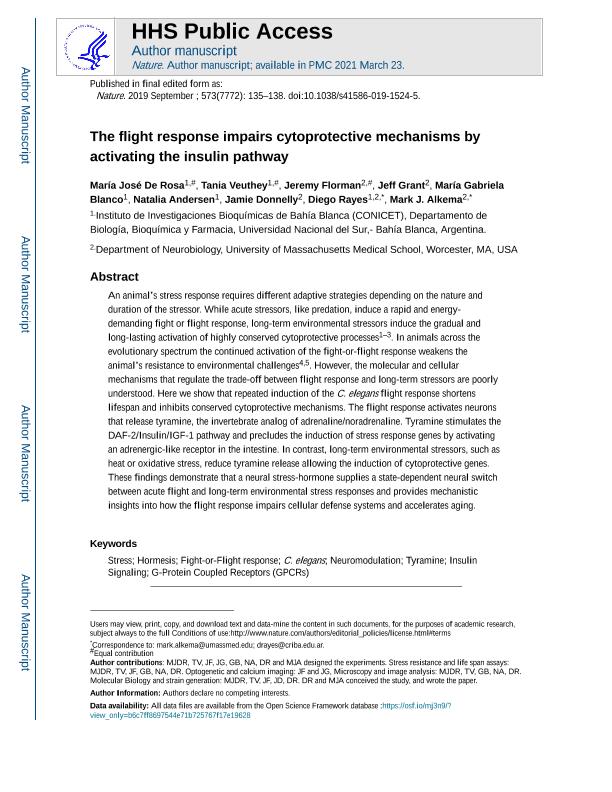Mostrar el registro sencillo del ítem
dc.contributor.author
de Rosa, Maria Jose

dc.contributor.author
Veuthey, Tania Vanesa

dc.contributor.author
Florman, Jeremy
dc.contributor.author
Grant, Jeff
dc.contributor.author
Blanco, Maria Gabriela

dc.contributor.author
Andersen, Natalia Denise

dc.contributor.author
Donnelly, Jamie
dc.contributor.author
Rayes, Diego Hernán

dc.contributor.author
Alkema, Mark
dc.date.available
2020-03-10T17:27:01Z
dc.date.issued
2019-08-28
dc.identifier.citation
de Rosa, Maria Jose; Veuthey, Tania Vanesa; Florman, Jeremy; Grant, Jeff; Blanco, Maria Gabriela; et al.; The flight response impairs cytoprotective mechanisms by activating the insulin pathway; Nature Publishing Group; Nature; 573; 7772; 28-8-2019; 135-138
dc.identifier.issn
0028-0836
dc.identifier.uri
http://hdl.handle.net/11336/99032
dc.description.abstract
An animal’s stress response requires different adaptive strategies depending on the nature and duration of the stressor. Whereas acute stressors, such as predation, induce a rapid and energy-demanding fight-or-flight response, long-term environmental stressors induce the gradual and long-lasting activation of highly conserved cytoprotective processes1,2,3. In animals across the evolutionary spectrum, continued activation of the fight-or-flight response weakens the animal’s resistance to environmental challenges4,5. However, the molecular and cellular mechanisms that regulate the trade-off between the flight response and long-term stressors are poorly understood. Here we show that repeated induction of the flight response in Caenorhabditis elegans shortens lifespan and inhibits conserved cytoprotective mechanisms. The flight response activates neurons that release tyramine, an invertebrate analogue of adrenaline and noradrenaline. Tyramine stimulates the insulin–IGF-1 signalling (IIS) pathway and precludes the induction of stress response genes by activating an adrenergic-like receptor in the intestine. By contrast, long-term environmental stressors, such as heat or oxidative stress, reduce tyramine release and thereby allow the induction of cytoprotective genes. These findings demonstrate that a neural stress hormone supplies a state-dependent neural switch between acute flight and long-term environmental stress responses and provides mechanistic insights into how the flight response impairs cellular defence systems and accelerates ageing.
dc.format
application/pdf
dc.language.iso
eng
dc.publisher
Nature Publishing Group

dc.rights
info:eu-repo/semantics/openAccess
dc.rights.uri
https://creativecommons.org/licenses/by-nc-sa/2.5/ar/
dc.subject
CAENORHABDITIS ELEGANS
dc.subject
TYRAMINE
dc.subject
ACUTE STRESS RESPONSE
dc.subject
AGEING
dc.subject.classification
Otras Ciencias Biológicas

dc.subject.classification
Ciencias Biológicas

dc.subject.classification
CIENCIAS NATURALES Y EXACTAS

dc.title
The flight response impairs cytoprotective mechanisms by activating the insulin pathway
dc.type
info:eu-repo/semantics/article
dc.type
info:ar-repo/semantics/artículo
dc.type
info:eu-repo/semantics/publishedVersion
dc.date.updated
2020-02-26T20:11:53Z
dc.journal.volume
573
dc.journal.number
7772
dc.journal.pagination
135-138
dc.journal.pais
Reino Unido

dc.journal.ciudad
Londres
dc.description.fil
Fil: de Rosa, Maria Jose. Consejo Nacional de Investigaciones Científicas y Técnicas. Centro Científico Tecnológico Conicet - Bahía Blanca. Instituto de Investigaciones Bioquímicas de Bahía Blanca. Universidad Nacional del Sur. Instituto de Investigaciones Bioquímicas de Bahía Blanca; Argentina. Universidad Nacional del Sur. Departamento de Biología, Bioquímica y Farmacia; Argentina
dc.description.fil
Fil: Veuthey, Tania Vanesa. Consejo Nacional de Investigaciones Científicas y Técnicas. Centro Científico Tecnológico Conicet - Bahía Blanca. Instituto de Investigaciones Bioquímicas de Bahía Blanca. Universidad Nacional del Sur. Instituto de Investigaciones Bioquímicas de Bahía Blanca; Argentina. Universidad Nacional del Sur. Departamento de Biología, Bioquímica y Farmacia; Argentina
dc.description.fil
Fil: Florman, Jeremy. University of Massachussets; Estados Unidos
dc.description.fil
Fil: Grant, Jeff. University of Massachussets; Estados Unidos
dc.description.fil
Fil: Blanco, Maria Gabriela. Consejo Nacional de Investigaciones Científicas y Técnicas. Centro Científico Tecnológico Conicet - Bahía Blanca. Instituto de Investigaciones Bioquímicas de Bahía Blanca. Universidad Nacional del Sur. Instituto de Investigaciones Bioquímicas de Bahía Blanca; Argentina
dc.description.fil
Fil: Andersen, Natalia Denise. Consejo Nacional de Investigaciones Científicas y Técnicas. Centro Científico Tecnológico Conicet - Bahía Blanca. Instituto de Investigaciones Bioquímicas de Bahía Blanca. Universidad Nacional del Sur. Instituto de Investigaciones Bioquímicas de Bahía Blanca; Argentina
dc.description.fil
Fil: Donnelly, Jamie. University of Massachussets; Estados Unidos
dc.description.fil
Fil: Rayes, Diego Hernán. Consejo Nacional de Investigaciones Científicas y Técnicas. Centro Científico Tecnológico Conicet - Bahía Blanca. Instituto de Investigaciones Bioquímicas de Bahía Blanca. Universidad Nacional del Sur. Instituto de Investigaciones Bioquímicas de Bahía Blanca; Argentina. Universidad Nacional del Sur. Departamento de Biología, Bioquímica y Farmacia; Argentina. University of Massachussets; Estados Unidos
dc.description.fil
Fil: Alkema, Mark. University of Massachussets; Estados Unidos
dc.journal.title
Nature

dc.relation.alternativeid
info:eu-repo/semantics/altIdentifier/url/https://www.nature.com/articles/s41586-019-1524-5
dc.relation.alternativeid
info:eu-repo/semantics/altIdentifier/doi/http://dx.doi.org/10.1038/s41586-019-1524-5
Archivos asociados
